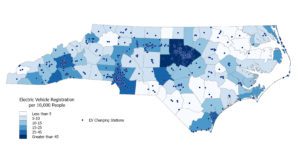Driving Forces in NC: Investing Volkswagen Mitigation Program Funds into Equal Access of Electric Vehicles & Charging Infrastructure

This feature highlights the importance of including low-to- moderate income households and underserved communities in the process of decarbonizing North Carolina’s transportation sector. In particular, the article focuses on the implications that recent funding and state mandates have on these communities. A broader discussion on the topic can be found in this NCSEA article.
The clean energy transition is well underway in North Carolina. Momentum to electrify the transportation sector continues to grow as a result of wide-scale bi-partisan support, economic opportunity, and significant pools of funding. Recent Executive Orders (EOs) by Governor Cooper have also signaled market readiness for North Carolina to take the lead on electric vehicle (EV) adoption. As NC invests in these initiatives, prioritizing rural areas and underrepresented communities is becoming increasingly imperative to enable all of NC to experience the benefits of a clean energy future.
The context of decarbonization in NC’s transportation sector
The North Carolina Department of Environmental Quality (DEQ) recently released a greenhouse gas (GHG) inventory of the state, highlighting that transportation is now the largest emitting sector within NC, comprising 36% of total emissions. To effectively address emissions economy-wide, Governor Cooper established emissions targets of 50% reduction by 2030 and carbon-neutrality by 2050. These goals established in EO246 build off the previous goals and mandates within EO 80 and House Bill 951.
Even further, EO 246 established additional goals for transportation sector: 1.25 million zero-emission vehicles (ZEVs) on the road by 2030 and 50% of all in-state new vehicle sales as ZEVs by the same date. The state recently reached approximately 28,000 ZEVs registered on its roads, and experts anticipate future growth to be exponential due to technological innovations and favorable market conditions.
EO 246 also tasked NC DEQ’s sister agency, the NC Department of Transportation (DOT), with building a Clean Transportation Plan by April 2023. A pillar of the plan’s strategic approach is to include voices historically underrepresented, such as low-to-moderate income communities, in the discussion about EVs and clean infrastructure development.
Funding the future of transportation electrification in NC
Funding is a crucial aspect of bolstering EV adoption and charging infrastructure as the state experiences an influx in infrastructure investment, “the most in a generation,” according to NC DEQ Secretary Elizabeth Biser. On top of significant federal funding, the state is set to receive approximately $92 million from the $2.8 billion Volkswagen emissions-cheating settlement, known as the NC VW Mitigation Program. The importance of forward-thinking, inclusive programs is at an all-time high as investments are allocated.
NC DEQ’s Department of Air Quality, the entity in charge of distributing VW funds, awarded $2.8 million in Phase 1 to replace school and transit buses across the state. We have now entered Phase 2, where $63.9 million will be targeted to further fleet replacements and bolster charging infrastructure in priority corridors, coastal evacuation routes, and rural areas. These programs include the following (in millions): Transit ($13.5), Clean Heavy-Duty ($12.9), School Bus ($27.1), EV Charging Infrastructure - DC Fast ($7.1) and Level 2 ($2.0).
Importantly, NC DEQ is attempting to address the energy burden of historically underserved communities that have yet to be included in the EV movement, as seen in Figure 1.

Figure 1: EV Registrations in NC per 10,000 people and EV Charging Stations (source: NCSEA)
EV Charging Deserts & Inequality in NC
NC DEQ’s Historically Under-Resourced County Outreach Program intends to include counties unfunded in Phase 1 while providing additional technical support and guidance for underserved communities. A focus is being placed on counties identified as economically distressed that have the highest percentages of underserved populations. These populations meet certain racial and poverty criteria determined by DEQ’s Environmental Justice Program. According to the NC Department of Commerce, 37 Historically Under-Resourced Counties, illustrated in Figure 2, were selected and are eligible for the maximum funding amounts allowed by the VW Mitigation Program.

Figure 2: Historically Under-Resourced Counties in NC (Source: NC DEQ)
Another target of the program is to address and eliminate charging deserts across the state. Comparing Figures 1 & 2, it is evident where EV adoption and infrastructure are located, around hubs like Asheville, Charlotte, the Triangle area, and more affluent coastal communities. To effectively tackle the pressing issues of inequal adoption, as well as range anxiety and charging deserts, intentional allocation of funding is required in Phase 2. Policy and utility collaboration remain other key elements to support this transition, as seen in examples like the EV Pilot Program in Vision 2025 of northeastern NC’s Roanoke Electric Cooperative.
Redesigning the map of EVs in NC
There is much work to be done to improve access to EVs and charging infrastructure in NC. NCSEA applauds NC DEQ’s work to increase the participation of historically underfunded counties in the context of EV adoption and charging infrastructure. Phase 2 of allocating funding from the VW Mitigation Program will be imperative to address the energy burden of these populations in the future. Furthermore, increased awareness of funding opportunities will aid in allowing all North Carolinians to experience the benefits of clean energy and electric vehicles.
Visit NC DEQ’s Historically Under-Resourced County Outreach Program webpage to learn more about the initiative and apply for project funding. Also, use its project eligibility tool to see if your project is eligible for VW Mitigation Program Funding.

